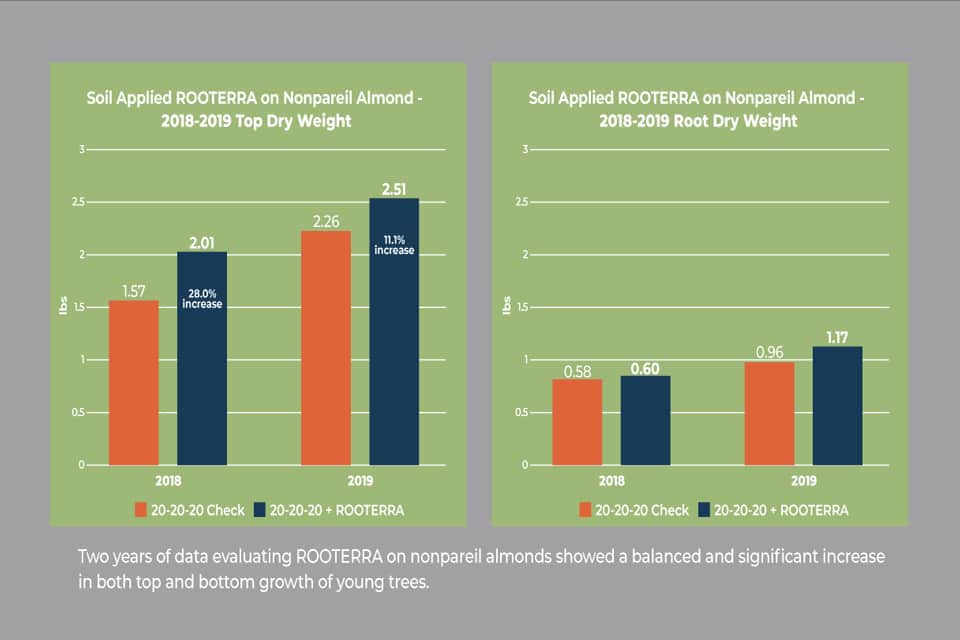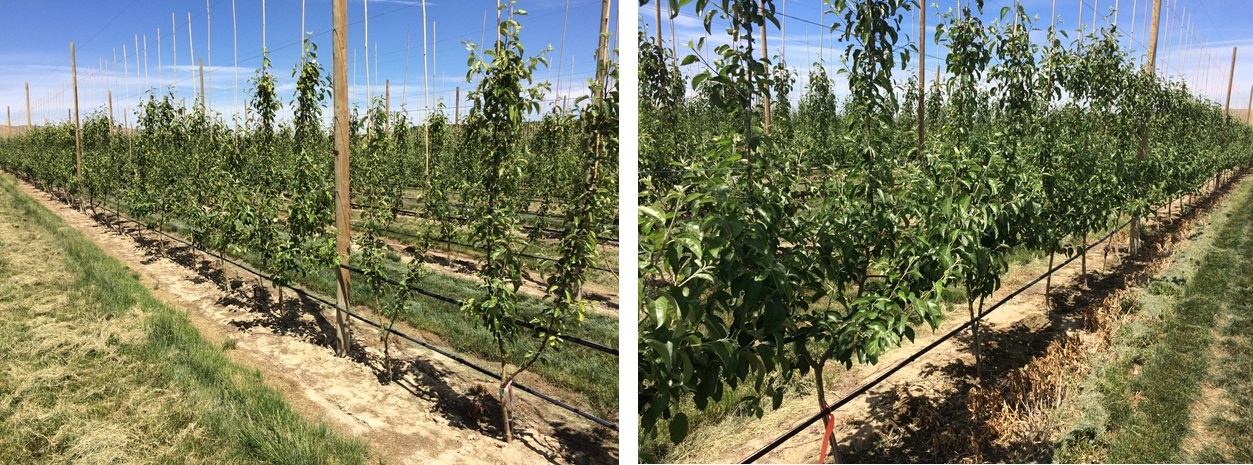The period after planting can be a touchy time. Young plants are especially vulnerable to environmental stressors and other challenges until root systems are well established. This is especially true for permanent crops such as grapes, fruit and nut trees, and berries. These long-term crops need to get established quickly in order to begin to yield fruit in a timely manner for the grower, and it needs to happen the right way. Strong, well-developed root systems are needed to support trees or vines for many years through everything nature throws at them, and still provide optimum yield.
‘Cosmic Crisp’ apples trees showed a 69% increase in branching one year after being treated with ROOTERRA (right) versus untreated. Trees were treated two times in June.
Biostimulant boosts root and stem growth, getting plants off to a good start that will last for years
Providing nutrition with macro and micronutrients in the right balance, of course is key. Along with that, research increasingly shows that fertilizer isn’t the complete answer. Plant roots have a highly evolved, complex relationship with the soil, and everything plays a part: the porosity, organic and inorganic matter content, and microbial activity.
This is where biostimulants come in. While these may provide some actual nutrients, their real value is they stimulate natural processes to enhance nutrient uptake, nutrient efficiency, tolerance to abiotic stress and crop quality. Often biostimulants are used to quickly boost growth of annual crops such as lettuce or corn, allowing for an earlier harvest or extra yield. But they can have benefits for permanent crops, too.
Data Shows Early Advantage in Apples, Grapes and Almonds
Nutrient TECH explored this potential with its biostimulant, ROOTERRA™ 9-3-7. ROOTERRA technology has been in use for years in Europe on annual crops, but it has just been registered in California and in the Western U.S. Tom Gerecke, Product Development Manager at Nutrient TECH, says Wes Asai, former University of California farm adviser and owner of Wes Asai Pomology Consulting, conducted a two-year research study using ROOTERRA on newly planted almond trees.

“One of the things Wes – and of course we at Nutrient TECH – were most excited about was the increase in these young trees in both top and bottom growth,” Gerecke says. “Often you see an increase in just one or the other. We’ve got two years of data, on that with an increase in each year resulting in 11-28% more top growth and 3.4-10.7% more root growth on those trees.”
A study in Washington in a newly planted high-density apple orchard showed similar results, Gerecke says. “One year later, the untreated trees averaged nine branches per tree. The ROOTERRA treated trees averaged 14.3 branches per tree. And to be very candid, the study got going later in the season than we would have liked, and we still had those results. While it’s too early to tell if more branches translate directly to more flowers and more yield, what we do know is ROOTERRA boosted the growth and vigor of those trees, and that is always what you want in those early years.”
Grapes are another high-value permanent crop that showed an increase in shoot growth and number of bunches the year after planting in a study conducted in Soledad, CA. In the cases of the apple and grape studies, they will be continued into a third year in order to quantify yield response.
“The technology behind ROOTERRA has been studied by our sister company in Europe for a long time,” Gerecke says. “There’s excellent data on corn, grain, soybeans, vegetables and leafy greens from that research. They just haven’t done as much with the permanent crops. But that’s what we are interested in because we know we will see the same results. So far, we have not found a plant that hasn’t responded to it.”
Better uniformity and earlier growth response are also benefits, because they can save labor in terms of training the crop. If growth is more uniform, fewer trips into the field are required to fasten branches to wires.
Compatibility and Low Rate
Gerecke recommends applying ROOTERRA when the ground warms up and plants are living off what their roots are absorbing rather than energy that was stored over the winter. Two to four applications two to four weeks apart, starting when the ground warms in your area makes sense, he says, and you’ll get better product uptake. ROOTERRA is a liquid, compatible with most common fertilizers, and is easily applied through fertigation. Because it isn’t required in large amounts, it can be tank-mixed with other fertilizers.
“I’ve had dealers tell me they like the application rate,” Gerecke says. “It doesn’t need to be applied at 10 or 20 gallons per acre like some non-specific biological additive.
“In the end, getting the plants established early and well can provide benefits far down the road with permanent crops, whether it’s improved drought resistance, increased first yields, more uniform growth, or less susceptibility to insects or disease. As a human being, you may take vitamins and supplements to boost your health overall. That’s what a strong, fast start provides for young plants.”



